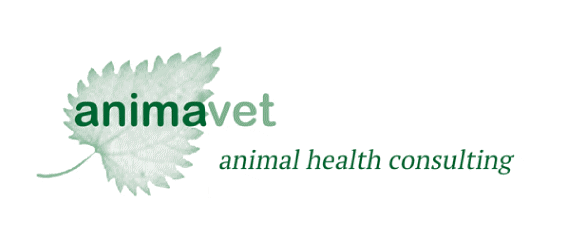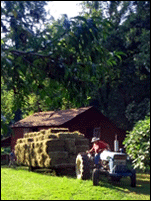
Christine King BVSc, MANZCVS (equine), MVetClinStud
Why test your hay and pasture?
Why should you have your hay and/or pasture tested? Because it’s not possible to know its nutrient content any other way. You can generally spot a 'bad' hay or poor pasture just by its appearance, but you cannot know the protein, sugar, and mineral content of a 'good' hay or pasture based on appearance alone — and these components matter, sometimes a lot! In some cases, they're the whole ball game.
- This photo was taken in Winston-Salem, North Carolina, where I was living before returning home to Australia. This locally grown, mixed-grass hay looked good and smelled wonderful, and the animals loved it, but its mineral profile caused some serious problems in the goats it was feeding. It is not possible to know the nutrient content of a forage without having it tested.
Forages, or 'roughage' — whether as pasture, hay, haylage, chaff, hay cubes, or hay pellets — should form the foundation of every horse’s diet after weaning, no matter what the horse does for a living.
- A vet I once knew who was also an equine nutritionist used to say "grain should be fed only as a supplement." I would add "and only to horses who need it." Not every horse needs grain, and not every horse needing grain needs all that much when the diet is based on good quality forages.
- It's the best use of your budget to spend your money first and most on good quality forages, not on bags of processed feeds and buckets of supplements. Your horse will be the healthier for it, as will your bank account when you factor in the health, hoof, and performance problems you'll avoid by cutting down or cutting out the high-carb bagged feeds.
Knowing the nutrient profile of your principal forages can make all the difference when it comes to...
- fertility (mares and stallions)
- pregnancy (mare) and gestation (foal)
- foaling
- lactation and neonatal (newborn) health
- growth and prevention of developmental orthopaedic diseases
- performance
- aging
- ability to cope with stress (physical and psychological)
- recovery after strenuous exercise, travel, or competition
- recovery from illness, injury, or surgery
- treatment and prevention of colic, laminitis, asthma, and other feed-related diseases (of which there are many!)
If you want to take a deep dive into this topic, then follow these links to specific components of the forage analysis:
nonstructural carbohydrates (NSC)
major minerals (Ca, P, Mg, Na, Cl, K, S)
trace minerals (Cu, Zn, Fe, Mn, Se, Co, I)
*****
Forage testing labs
None of the Australian forage testing labs currently provide a comprehensive, equine-specific package for a reasonable cost and workable timeframe, so I use the following two labs:
1. Feed Central in Toowoomba, QLD
On their current order form, select the Dairy One Feed Test in Step 3 (even though it's designed for ruminants*). In the Comments section in Step 2 directly above it, write that the sample is for horses.
- Check the 24-hour turnaround box, and provide my name and email address if you want a copy of the results sent to me as well.
- Check the 'yes' box if you want the lab to send you some (more) of their prepaid post bags, sample collection bags, and sample submission forms.
- Currently, this package costs $77 (including GST).
* This package will provide almost everything we need for horses, but it doesn't include trace minerals. That's where SCU-EAL comes in...
2. Southern Cross University Environmental Analysis Laboratory (SCU-EAL) in Lismore, NSW
In their current agricultural price list, select the Plant Testing package PA-PACK-001 (top of page 11) for trace mineral analysis. The current cost is $55 (including GST). This package doesn't include selenium, but I'm working on that...
Here are links to their blank submission form, an example of how to fill it in, and a shipping label for your samples. (You'll need to pay the postage on these samples, though.)
- This lab is not fast; their stated turnaround time is 5 working days, so you'll usually get your results about a week after the lab receives your sample.
- Feed Central also offers the Equi-Tech package by Equi-Analytical in the US, but while this comprehensive, equine-specific analysis includes trace minerals, the sample has to be sent to the US, so it can take 2 weeks or more to get the results. With COVID-19 slowing everything down, it can take even longer at present.
***
Feed Central's Dairy One Feed Test is a good option for checking the moisture, crude protein, and starch and sugar content of a forage. Starch and water-soluble carbohydrate content are particularly important for horses needing a calorie-controlled or low-carb diet. By checking the '24 hours' turnaround box, you'll have your hay results the day after the lab receives the sample (unless they get your sample on a Friday, in which case you'll have them on Monday). This test is money well spent if it saves you from buying a load of unsuitable hay.
Trace mineral analysis is important over the long haul, and it's something you should get done on your pastures at some point, but it's not likely to influence your hay-buying decisions the way moisture, crude protein, and water-soluble carbohydrate content do.
Collecting hay and pasture samples
These tests don’t need a lot of material. For hay samples, it’s enough to grab a few representative handfuls from the middle of a couple of different bales. (Make sure you take it from the middle of the slice, not the edges, which tend to be a bit weathered, no matter how well the hay is stored.) Mix the grab-samples together in a clean bucket or feed tub, and then put the blended sample in the collection bag I've given you or the lab sent you. (If you don't have one of the lab's collection bags, just use a ziplock bag.) Squeeze out all the air and seal the bag shut. Write a short description of the sample on the bag with a permanent marker (e.g., mixed grass hay).
For pasture samples, cut several representative handfuls of grass from various places in your pastures. Cut them off at ‘grazing’ height (a few centimetres above the soil), and sample a variety of areas that reflect the predominant soil and grass types in your pastures. It doesn’t matter if an area is well-grazed — in fact, that’s a good place to sample if there’s enough grass to cut — because it doesn’t matter how short or long the grass is; you’re simply wanting to sample what the horses are eating. Mix all of your cuttings together in a clean bucket or tub and then put the blended sample in the lab bag, as described above for hay samples.
The lab will dry the fresh pasture samples before analysis, so there's no need to do that yourself if you can mail the samples the same day or the next. That said, it’s best to wait until any rain or dew has evaporated from the pastures before taking your samples. If you’re collecting your pasture sample late in the day and you won’t get to the post office until the next day, put the sample in a sealed bag in the fridge overnight. It doesn’t have to go to the lab in a cooler; you just want to slow any mould growth.
If in doubt, call me or the lab. The staff at Feed Central's feed testing lab and SCU-EAL are excellent and they can answer any questions you may have about sample collection and processing.